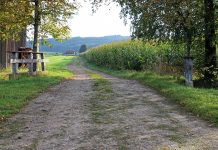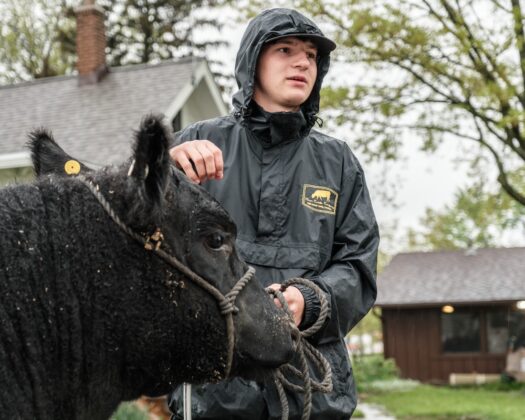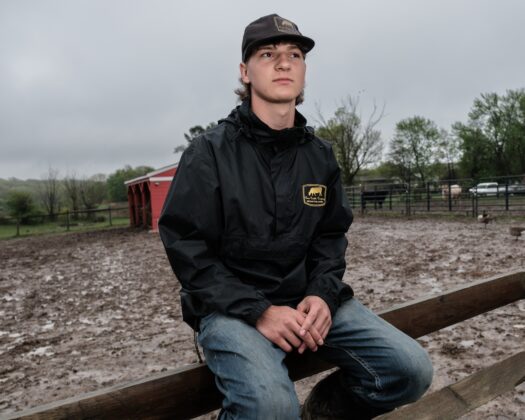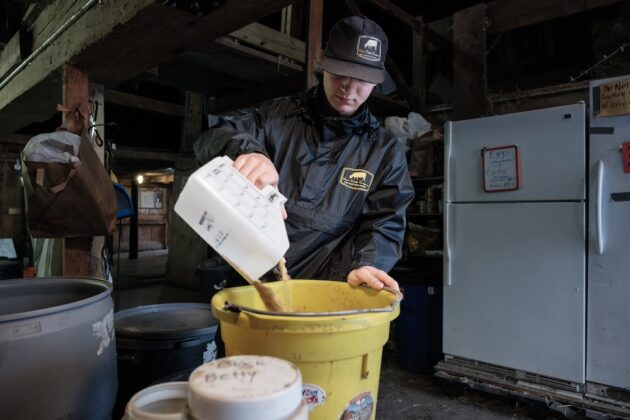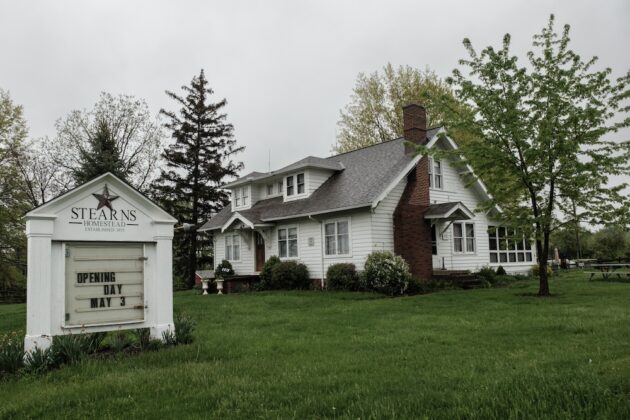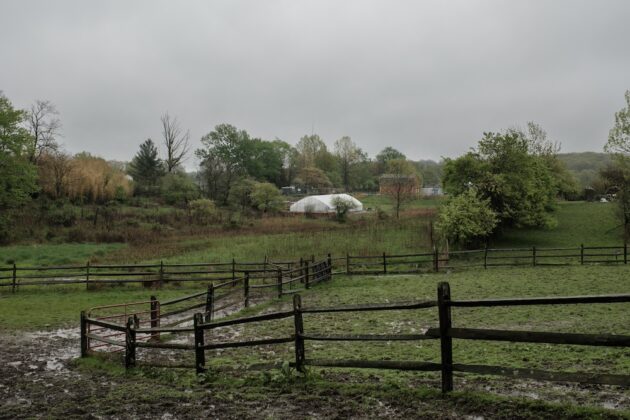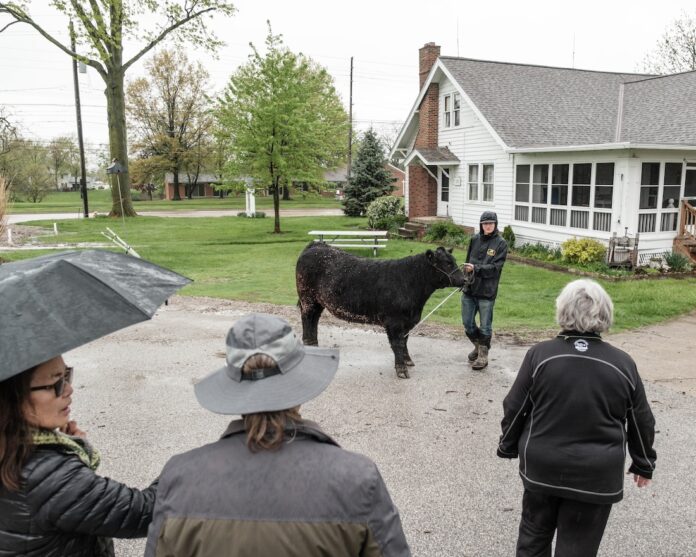
PARMA, Ohio — Soda Kiser walks his 4-H steer on a rope halter out of the barn at Stearns Homestead. It’s a rainy day, but Soda and the bovine seem unbothered by the steady drizzle as they head to the front of the farm for the Homestead Hoofers 4-H club Potential Buyers Night on May 3.
Soda stands with the black steer in the driveway of the homestead, talking about his 4-H projects and answering questions from visitors.
Before he joined the 4-H club in 2020, Soda said he never wore jeans, let alone boots. Now, the 18-year-old plans to attend the University of Findlay after graduating high school to study animal science. He has dreams of being involved in the cattle industry, in one way or another.
“It completely shifted my life when I started here,” Soda said.
About 100 yards behind them is Ridge Road, a busy five-lane thoroughfare that runs through Parma’s shopping district. Across the street is a shopping center that contains a Wendy’s, Outback Steakhouse, Kohl’s, Target and Giant Eagle.
Soda raises his 4-H market animals at Stearns Homestead, the historic city-owned educational farm, as part of the Homestead Hoofers’ agreement with the Parma Area Historical Society, which runs the farm. Stearns is the only farm left in Parma — Ohio’s seventh most populous city.
It’s also the only way for city kids like Soda Kiser to get any kind of experience with agriculture. Parma City School District does not have an agricultural education program or FFA chapter. Owning poultry or livestock is prohibited within city limits, except at Stearns Homestead, which receives a special exemption from the city’s rules.
“This is a special place,” said Renee Chapel, president of the Parma Area Historical Society and one of the 4-H club’s advisors.
Joining
Soda became interested in farming after watching YouTube videos at the start of the COVID-19 pandemic, when public life shut down and many people were stuck quarantining at home.
“Most kids were playing Minecraft, and he was watching farming videos,” said Dale Kiser, Soda’s father.
Getting into farming wouldn’t be easy for the teen who lived on a small corner lot in a suburban Parma neighborhood. Soda’s mother, Sabrina Kiser, also doubted whether Soda’s interest in agriculture went past the ease of watching videos on his phone.
Still, she wanted him to get a taste of what it was really like, so she searched for 4-H clubs near them and found one only minutes away from their home — the Homestead Hoofers, headquartered at the Stearns Homestead.
Soda joined in March 2020, and within two weeks, his younger brother, Cooper, had joined the club, too.
“We thought for sure both our boys would be like, ‘This is a lot of work,’” Sabrina Kiser said.
Soda is the first to admit that when he started in 4-H, part of his motivation was to prove his mother wrong. The two can be pretty competitive. But it soon turned into much more than that.
“The cattle have taken my heart,” he said.
Five years later, the brothers have raised various market animals for the Cuyahoga County Junior Fair, including steers, hogs, chickens, turkeys, rabbits and geese. Being in the 4-H club has also given Cooper opportunities beyond raising animals that he wouldn’t have had otherwise, like traveling to Washington, D.C., as part of the Ohio delegation for the Ignite by 4-H program. He was also nominated to travel to Puerto Rico through the 4-H Cultural Immersion Project later this year.
“If it wasn’t for Stearns, I wouldn’t have gotten to do these things,” Cooper said.

Caring
Stearns Homestead has been a farm for more than 170 years. Lyman and Rhoda Stearns bought the property in Parma in June 1854. Originally from New Hampshire, the couple liked the area after visiting Lyman’s brother, who lived in Copley, Ohio.
The farm’s low-slung Yankee-style barn was built around 1849, and the white farmhouse was built in 1855. Both buildings are still on the property today.
Earl C. Gibbs, a Cleveland meat processor, bought the Stearns farm in 1919, building another home there in the ‘20s. Gibbs raised black Angus cattle through the 1970s, at which point the suburbs surrounded the farm, according to the historical society. Parma, like many suburbs of major cities, developed rapidly in the economic boom after World War II.
The City of Parma bought the property from the Gibbs family in 1980 to preserve it as a historic and educational farm. The Parma Area Historical Society operates the homestead now, with help from the West Creek Conservancy.
The farm houses about 100 animals, including horses, ponies, mini donkeys, sheep, goats, turkeys, chickens, ducks, geese, rabbits, quail and one Vietnamese pot-bellied pig named Diva, Chapel said. The numbers go up to around 150 during peak season for fair market projects.
The 4-H’ers sign a lease agreement to rent space at the farm for their market projects. Not only do the 4-H’ers care for their animals, but they’re also responsible for caring for the farm’s animals and the property.
There’s a unique sense of camaraderie that develops within the Homestead Hoofers, Chapel said. Instead of caring for and working with their market animals individually at their home barns, it’s more like a group project.
“The kids come here to care for their animals together,” Chapel said. “They’re mentoring each other and hanging out with like-minded people.”
They also act as ambassadors for the farm and the program, said Homestead Hoofers 4-H lead advisor Alyssa Bower. The farm is open to the public on Saturdays from spring through the fall. Visitors can stop by and see the 4-H’ers working with their animals.
“These kids like to show off their animals and talk about them,” Bower said.
When Bower was a 4-H member from 2007 to 2010, the club had 15 to 20 members. She came back to advise the group in 2016, and the club is now the largest in Cuyahoga County with 70 members. There’s a waitlist to get in each year.
Growing
Being the largest club in one of the state’s most urban counties still comes with challenges. Sabrina Kiser said they’ve struggled with finding local businesses or community members to sponsor things like their junior fair’s grand champion and reserve champion banners.
“In our area, people don’t understand what 4-H is,” Sabrina Kiser said. “They don’t understand the junior fair market auction or how hard the kids work in order to do this. We want people to see what these kids are doing.”
For example, the Cuyahoga County Junior Fair 4-H Livestock Sale brought in $66,744 from 67 lots last year. In comparison, the neighboring Lorain County Junior Fair brought in more than $1 million in sales from nearly 600 market lots at last year’s fair.
Events like the Potential Buyers Night are an important part of the club’s continuing efforts to increase visibility and awareness of the county’s small but mighty agricultural programs, Sabrina Kiser said.
Some people do see the magic that’s happening at Stearns. Tom Chuna, a lifelong Parma resident, attended last year’s Homestead Hoofers Potential Buyers Night and ended up buying a market hog from one of the 4-H’ers at the fair.
“These kids just impressed the heck out of me,” he said, with the ease and comfort with which the 4-H members could talk to adults about their projects.
He was so moved that he talked his company, Benjamin Franklin Plumbing of Medina and Greater Cleveland, into sponsoring events and animal care at Stearns.
“These kids represent what is right in America,” he said.



